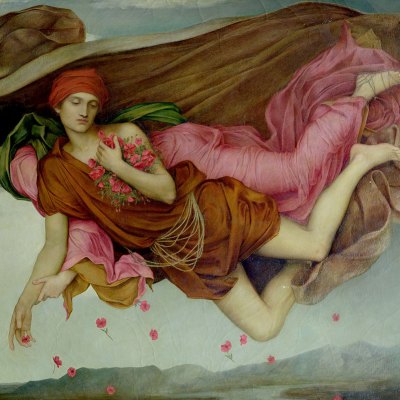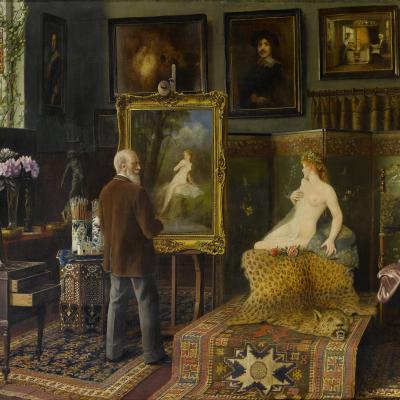According to art history, men look at women; women are looked at; women prime themselves for that reciprocity. Assembled from the founding collection of the Frye Art Museum in Seattle, the year-long exhibition ‘Unsettling Femininity’ takes this lingering, salacious gaze as its subject. It presents mostly German and Austrian representations of girlhood, womanhood, and femininity, produced almost entirely by men between the mid 19th and early 20th centuries; it asks what we – and our institutions – have inherited from our forebears.
Charles and Emma Frye, Iowan-turn-Seattleite descendants of German immigrants, made their fortune in meat packing and sales. After their first trip to Europe in 1914, where they had hobnobbed with celebrities, nobles, and Bavarian millionaires, the couple devoted themselves to developing their own gallery, in direct response to the studios of the ‘painter-princes’ of Munich. When Charles Frye died in 1940, their collection became the basis of the Frye Art Museum, which opened to the public in 1952. This founding collection comprises pastoral landscapes, hoary portraits, moulting ducks – and representations of women that are variously quotidian and mythological, sometimes erotic, and often unsettling.
The exhibition’s opening confrontation is with Stella (c. 1889), a Venus Anadyomene by Gustav Majer that, according to the Fryes’ niece, once lived in a backroom at the meat-packing plant, behind a curtain. Stretching from the waves, toying with a pearl necklace, she meets your gaze, as if to offer up her hairless, waxen body. Her loose locks frame her hips; blue and yellow tones striate her legs, like bruises. In Franz Xaver Winterhalter’s Susanna and the Elders (1866), Susanna rushes to cover her nude body, grasping for the adjacent drapery. We, the viewers, are invited to join the two elders skulking in the background shrubbery in assessing Susanna – confusingly, for both her instinctive modesty and her ideally configured body.
Susanna and the Elders (1866), Franz Xaver Winterhalter. Frye Art Museum, Seattle. Photo: Spike Mafford

Stella, Aphrodite, Hera, Athena, an anonymous sun maiden, Susanna, Sin, Romany women, and bucolic Northern European frolickers – women are well represented here but these subjects, rendered creamy and generic, appear to exist only in the realm of the representation. One imagines the canvas turning black, shutting down, as soon as the looking ends, and we depart the fantasy space. Who are these women without their audience? They are anonymous, interchangeable, and unrelatable. Activated by the gaze, they exist in what Margaret Atwood has called ‘suspended animation’; these are paintings about ‘waiting, about objects not in use’.
Some of the sitters are decidedly specific: celebrity portraits make up a substantial portion of the Frye founding collection. Italian actor Eleonora Duse, American opera singer Geraldine Farrar, German actor Hannah Ralph, and dancer Paulina Clarissa Molony jut their chins, shift their weight, and peer up below tinted eyelids. Molony – also known as Saharet – appears in two portraits, one by Franz von Lenbach (1899) and the other by Franz von Stuck (1902). Lenbach captures a romantic gaze and warm features, clearly enchanted by the person he deemed the ‘most beautiful woman in the world’. Von Stuck applied a more modern lens, depicting Saharet in her stage make-up and a teeth-baring half-smile. Although these women would seemingly have held more negotiation power than an unnamed sitter – Saharet charged Lenbach for the privilege of painting her – their representations still feel divorced from their individuality.
Stella (1889), Gustav Majer. Frye Art Museum, Seattle. Photo: Richard Nichol

By the time I leave the exhibition space, having perused galleries of coquettish childhood portraits, maidens in fields, dancers and dancers and dancers, I am completely unsettled. My sense of repulsion is not a criticism of, but a credit to the exhibition and its curator, Naomi Hume, a professor of art history at Seattle University. ‘Unsettling Femininity’ highlights a crucial academic discourse that seldom makes its way into museums so powerfully or intelligently. As I look at Paris judging his three goddesses, I overhear museum-goers reading aloud the section panels and comparing their experiences to those on view.
When I ask Hume about the exhibition, she points to Lenbach’s Voluptas, painted in 1897 and titled after the Roman goddess of pleasure. As her clothes slide past her hips, Voluptas leans back, privately enraptured; her hair hangs loose like Stella’s. Hume tells me that her students often perceive this painting as inherently self-expressive, as though the woman is alone rather than portrayed and seen by painter and viewer. Despite shifting attitudes towards women and power, she finds that her students ‘identify with [the sitter] rather than seeing it as an objectifying image and they talk about how free she looks and how she’s experiencing her sexuality’. Perhaps influenced by a culture of consciously crafted imagery and selfies, ‘they still want to picture themselves in ways that are disempowering for themselves, even though they experience that as empowering’.
Voluptas (1897), Franz von Lenbach. Frye Art Museum, Seattle. Photo: Spike Mafford

Happily, the last gallery of ‘Unsettling Femininity’ feeds directly into the temporary exhibition ‘Dress Codes: Ellen Lesperance and Diane Simpson’. The contemporary artists Lesperance and Simpson provide alternative feminine representations through drawn, painted and sculpted translations of women’s dress. In Window Dressing: Window 6, Collar and Bib-deco (2007/2008), for instance, Simpson remodels a three-dimensional retail display in grid-like teal, black, and white pixels. Lesperance reproduces items of clothing based on, for example, a photograph of a protester in Tahrir Square during the Egyptian Revolution. They reflect on the socially constructed vocabulary around women’s bodies yet also tease out the sartorial relics of collective action and personal strength. ‘‘Dress Codes’ does not deny the existence of the gaze, but offers new ways of looking and, thus, being. Although femininity has been canned and repackaged over the past century, Lesperance and Simpson suggest the possibility of an eventual reinvention – maybe even freedom.
‘Unsettling Femininity: Selections from the Frye Art Museum Collection’ is at the Frye Art Museum, Seattle, until 23 August 2020.



